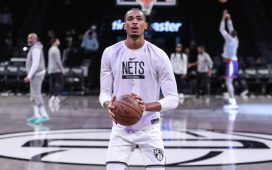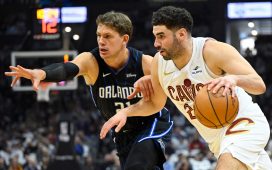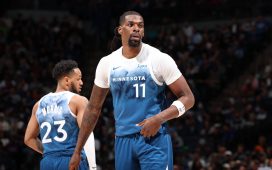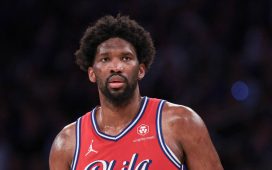Let’s start here: It takes giant stones for a team to trade its 25-year-old All-Star for future considerations. Doubly so when that player has one of the league’s most favorable contracts, paying him just $33 million over the next two seasons. Triply so when that team is rebuilding and should be trying to acquire exactly the kind of player it’s sending out.
So, why, exactly, would the San Antonio Spurs agree to trade Dejounte Murray to the Atlanta Hawks on Wednesday in exchange for a lot of draft picks, but essentially no tangible basketball help for the immediate future? (Danilo Gallinari is the only player coming from Atlanta, but his partially guaranteed deal for $21 million — with the guarantee adjusted up to $11 million to make the trade legal — will almost certainly be waived.)
Let’s start with one odd quirk of Murray’s contractual situation: He actually didn’t make enough money for the Spurs to feel secure about keeping him long-term. Because the final year of his deal only paid him $17 million, San Antonio had no chance of signing him to the type of multi-year extension that has become common practice with most All-Star (or even near-All-Star) players when his contract nears expiration in 2024.
Yes, San Antonio had enough cap room to do a “renegotiate-and-extend” deal with Murray, but even this pathway was fraught. It essentially would’ve required the Spurs to commit to a huge payday extending out Murray’s current contract for three more years and front-load the money, too. All this for a player who wasn’t quite good enough to be the centerpiece of a playoff team.
So we ended up in this bizarre place instead, where the Spurs began the 2021-22 season with an elite defensive backcourt of Murray and Derrick White … and roll into 2022 free agency with four future firsts in their place and Doug McDermott as their highest-paid player.
At some level, the Spurs’ situation was the result of a post-Kawhi Leonard rebuild that had been simultaneously too successful and not successful enough. The Spurs made a mistake in not moving on from LaMarcus Aldridge at the same time, but the biggest issue was that they found players like White, Murray and Keldon Johnson with late draft picks and added solid late-lottery talent like Devin Vassell and Jakob Poeltl around them. In doing so, they assured that they wouldn’t be bad enough to have a realistic chance of finishing in the top four in the lottery, yet wouldn’t be good enough to win anything important.
Murray was good, but he wasn’t good enough to change that. The haul the Spurs got from trading him, White, DeMar DeRozan and Thaddeus Young in the past 12 months might be. Of the picks the Spurs received from Atlanta in the Murray trade, three come with the juicy word “unprotected” attached: firsts from Atlanta in 2025 and 2027 and a pick swap in 2026. This is betting on the Hawks to fail, to some extent, which is why San Antonio pushed out the receipt of these picks a few years. The fourth pick, a 2023 lottery-protected first from Charlotte that could turn into two seconds in 2025, isn’t nearly as valuable.
That’s not all the draft equity the Spurs now own. They have a lightly protected 2025 first-rounder from Chicago still headed their way from last summer’s DeRozan sign-and-trade deal and a 2028 pick swap with Boston that is top-one protected from the White trade. San Antonio also just used the 20th and 25th selections in last week’s draft, in addition to its own pick at No. 9, as a result of trading White and Young.
Of course, focusing on all that ignores the elephant in the room. Or rather, l’éléphant. By far the biggest piece of draft equity the Spurs now own is their own first-round pick in 2023, when it just so happens the most prized player in the draft class is French prodigy Victor Wembanyana, who just so happens to play for ASVEL Basket, which just so happens to be owned by former Spurs star Tony Parker.
Even if the Spurs don’t luck into the top pick (the worst three teams only have a 14-percent chance each now; kudos to the league for disincentivizing tanking to the extent it could), San Antonio is virtually guaranteed a top-six pick in a strong draft with this roster. It’s hard to imagine this team being any good in 2022-23. It’s one with about 16 different “interesting” shooting guards — hey, the nice thing about a Josh Richardson/Malaki Branham/Joshua Primo/Blake Wesley/Devin Vassell lineup is that you can still bring Lonnie Walker (should he re-sign) and Romeo Langford off the bench. Meanwhile, without Murray, the best player remaining is … Jakob Poeltl?
San Antonio has max cap room, but why bother using it this year? The Spurs will have the rare “double max” space next summer, potentially allowing them to add two max-contract players. That’s a long shot, but even though the bright lights of Bexar County aren’t exactly a tractor beam for free agents, the Spurs could sign a whole new quintet of 6-foot-5 shooting guards with their estimated $70 million to $75 million in projected cap room. More seriously, they could easily position themselves to sign three starter-caliber players from a strong free-agent class, put those players around their 2023 lottery pick and the three firsts from this year and be on their way back up the standings.
Meanwhile, the Spurs can use their remaining projected $36 million in 2022 cap room not to chase overpays on restricted free agents, but to take in unwanted contracts from other teams looking to trim salary. Sure, they could use some of it on stopgaps to keep things quasi-respectable — signing Tyus Jones so these kids can learn while playing with a real point guard, for instance — or on “delayed sign-and-trades” for a veteran or two they can then pawn off for a draft pick at midseason. (Speaking of which, keep an eye on Richardson.) But if a team calls looking to dump a contract, San Antonio should be all ears. (One thought: McDermott for Russell Westbrook and Laker firsts in 2027 and 2029.)
That’s a lot of words on a team that isn’t going to be very good this year. What about the other side of this?

Trae Young finally has a running mate that can alleviate his weaknesses. Brett Davis / USA TODAY Sports
Atlanta had two glaring needs from last season. First, literally anybody at all who could defend on the perimeter. Second, another shot creator to reduce the strain on Trae Young. The Hawks got both those things in Murray, and if they overpaid a bit, you can hardly blame them. Murray was one of the few players who could fill this role on a reasonable salary while also offering enough shot-creation upside to allow the Hawks to actually survive in Young’s absence.
The trick is navigating the rest of the roster dance in the wake of this trade. The Hawks are almost out of draft-pick bullets, although they can still likely trade their 2023 first at the trade deadline for an upgrade. They’re also nearly $10 million into the luxury tax after the trade, even if they fill out the roster with minimum contracts. Even so, Atlanta still has a glaring paucity of real wings, particularly if De’Andre Hunter’s knees start acting up again.
Meanwhile, lurking just around the corner is the reality that the Hawks will have the same challenges extending Murray as the Spurs did. They’ll have to hope he likes the pairing with Young well enough to stick around past 2024, even though he’s almost certain to have the rock quite a bit less than he did in San Antonio.
Even so … the Hawks had do to this, right? They painted themselves into a corner with some previous roster decisions and this was an expensive way out of it. Atlanta still has to make some other moves to maximize this prime window of the Young-Murray backcourt. While John Collins rumors are all the rage, one has to think Kevin Huerter and Bogdan Bogdanović are extremely in play now too; between the two All-Star guards and rookie sharpshooter AJ Griffin, minutes for supplemental backcourt players like them suddenly seem scarce.
That said, despite the divergent strategic choices represented by this trade, there was one common theme: Nobody in the NBA wants to be in the middle for long. This is a league where you either push in your chips to win now or acquire said chips to win later. Atlanta went 43-39 last season and San Antonio went 34-48. Both teams were in the 2022 Play-In Tournament.
Suffice it to say, neither intends to be back in 2023.
Related reading
Harper: Grading the Hawks-Spurs trade
(Photo of Dejounte Murray: Brett Davis / USA Today)








